Is hooking up taking over from dating soon? Here are some facts on hookup culture statistics: how common it is, where it’s happening, and why people do it.
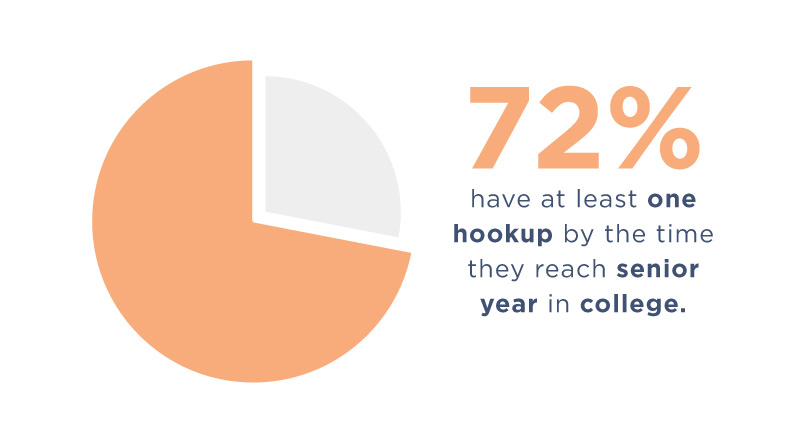
Casual sex and one-night-stands are nothing new. Since the dawn of civilization, people have been getting together on a no-strings-attached basis. And as is well documented, committed monogamy is something of an outlier in the animal kingdom, far from being the natural way of things.
But hookup culture is a pretty new concept that describes how casual sex and hooking up have become normalized. In some parts, it’s practically expected.
First, a quick definition. Hookup and hooking up are pretty loosely defined, so we’ve taken it to mean a sexual encounter between people who are not in any kind of committed relationship and can include anything from kissing to having sex. (It usually means sex, but not always in every study. Way to go, scientific and linguistic rigor!)
So today, we’ll be looking at hookup culture – what it is, where it’s happening, why people do it, and whether there are benefits and drawbacks to it (spoiler alert – there are both).
Top Hookup Culture Statistics
- Between 53% and 76% of college students have hooked up at least once in the US.
- The average American has the most hookups at the age of 27.
- 72% of both men and women have at least one hookup by the time they reach senior year in college.
- Men are generally more comfortable than women with all types of sexual behaviors during hookups.
- Men (30%) were more likely than women (12%) to regret a hookup because of a lack of physical attraction.
- 46.6% of students having sex during hookups use condoms.
- 69% of Americans would only start a “no strings attached” relationship with someone they had chemistry with.
- 60% of undergraduates have had an FWB relationship at some point in their life.
- 46.67% of women and 45.07% of men prefer traditional dating to hooking up.
- 17% of men and just 2% of women have a strong preference for hooking up over dating and relationships.
How Common Are Hookups?
Is everyone really sleeping with each other all the time without so much as a date between them?
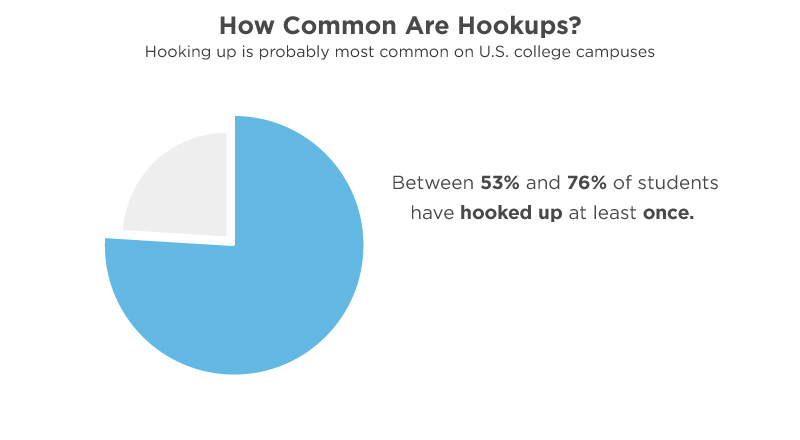
- Hooking up is probably most common on U.S. college campuses, where it is estimated that between 53% and 76% of students have hooked up at least once. (Journal of American College Health, 2018)1
- Another study of undergraduates in their first year of college found that 64% of men and 44% of women participated in casual hookup sex between the age of 14 and April of their freshman year. (Archives of Sexual Behavior, 2013)2
- The average American has the most hookups at the age of 27. (Study Finds, 2021)3
Hookups Among College Students
College hookup culture statistics and college culture are virtually synonymous in the US at this point. Since hookups are happening the most on campuses, plenty of studies and surveys are done on students to see what’s happening.
So, who’s hooking up with who in universities all across the country?
- Between 60% and 80% of North American college students report some experience with hookups. (Review of General Psychology, 2012)4
- 72% of both men and women have at least one hookup by the time they reach senior year in college. (University of California Merced, 2010)5
- By senior year, approximately 40% of students who had ever hooked up had engaged in 3 or fewer hookups. 40% had between 4 and 9, while 20% had 10 or more hookups. (University of California Merced, 2010)5
- Relatively little sexual activity occurs during hookups among college students. Only about 33% of students in one survey reported full intercourse during their last hookup. Another third had engaged in oral sex or manual stimulation of the genitals, and a full 20% of survey respondents in their fourth year of college had never had vaginal intercourse. (University of California Merced, 2010)5
- During their most recent hookup, 46.7% of students reported neither oral nor vaginal sex, 14.3% of students reported having oral sex only, 14.9% reported having vaginal sex only, and 24.1% reported having both oral and vaginal sex. (Archives of Sexual Behavior, 2011)6
- College students during their most recent hookup:
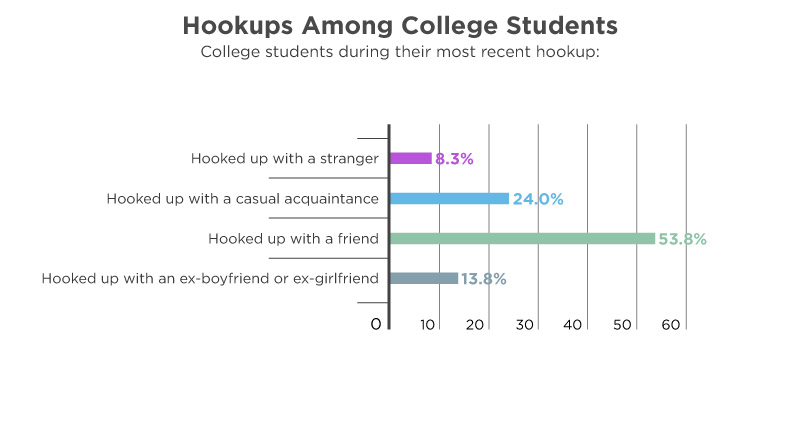
- 8.3% hooked up with a stranger
- 24.0% hooked up with a casual acquaintance
- 53.8% hooked up with a friend
- 13.8% hooked up with an ex-boyfriend or ex-girlfriend.
(Archives of Sexual Behavior, 2011)6
- The same study found that almost two-thirds (61.9%) of students reported that their most recent hookup was the first time they had hooked up with this particular partner. (Archives of Sexual Behavior, 2011)6
- On average, about 80% of students hook up less than once per semester over the course of their college careers. (University of California Merced, 2010)5
Young Adolescents Are Also Hooking Up
It’s not just college students who are having casual encounters, though.
Younger people are also engaging in hookups, though at a lower rate than their university-aged counterparts.
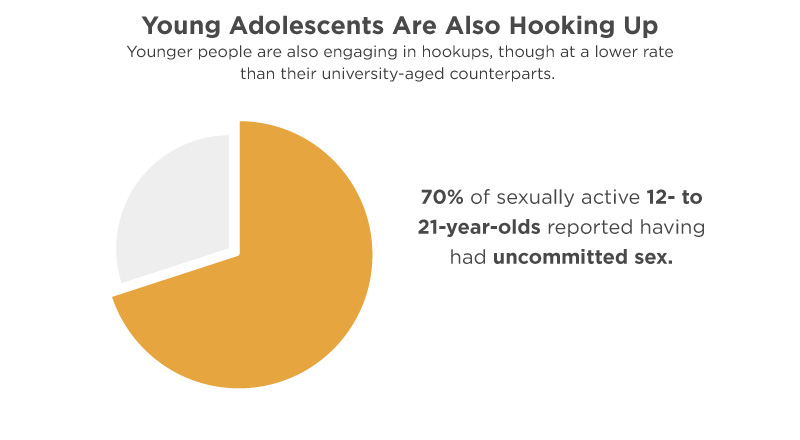
- Almost 15% of twelve to sixteen-year-olds and more than 40% of seventeen to twenty-one-year-olds who were virgins during one study engaged in casual sex or a sexual hookup the following year. (Adolescent & Family Health, 2003)7
- 70% of sexually active 12- to 21-year-olds reported having had uncommitted sex within the last year (American Psychological Association, 2013; (Adolescent & Family Health, 2003)8,7
- 60% of sexually active teenagers have had sex in both romantic and non-romantic contexts. The majority of sexually active teens have had some sexual experience outside of a romantic partnership. (Social Science Research, 2005)9
Gender Differences In Hookup Behaviors
Do men and women have different preferences? Do the old stereotypes have any truth to them, where women seek romance while men “only want one thing”?
Let’s see what the data has to say.
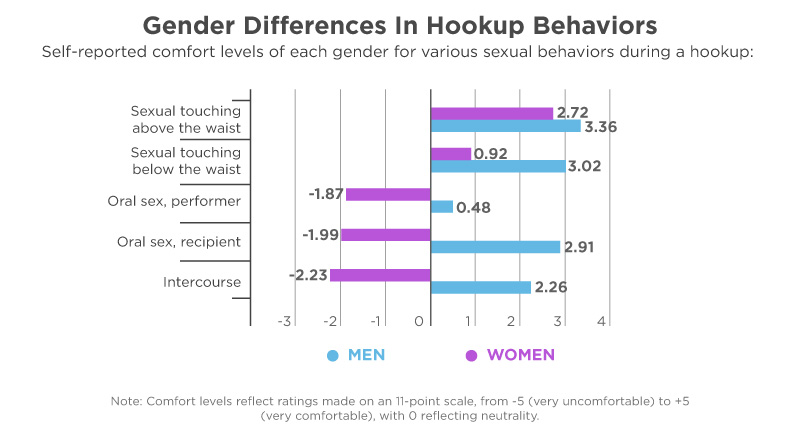
- Women tend to report fewer hookups, fewer hookup partners, and a general preference for traditional dating compared to men. (Journal of American College Health, 2018)1
- Men were more likely to be involved in hookup sex than women. During their first year on campus, 45% of men and 24% of women engaged in hookup sex. (Archives of Sexual Behavior, 2013)2
- Men are generally more comfortable than women with all types of sexual behaviors during hookups. However, the largest differences in comfort levels are receiving oral sex and intercourse. (Evolutionary Psychology, 2010)10
- Self-reported comfort levels of each gender for various sexual behaviors during a hookup:
*Note: Comfort levels reflect ratings made on an 11-point scale, from -5 (very uncomfortable) to +5 (very comfortable), with 0 reflecting neutrality.- Sexual touching above the waist
- Women: 2.72
- Men: 3.36
- Sexual touching below the waist
- Women: 0.92
- Men: 3.02
- Oral sex, performer
- Women: -1.87
- Men: 0.48
- Oral sex, recipient
- Women: -1.99
- Men: 2.91
- Intercourse
- Women: -2.23
- Men: 2.26
(Evolutionary Psychology, 2010)10
- Sexual touching above the waist
- In a survey about casual sex, men reported nearly twice as many hookups on average (28) as women (15). (Psychology Today, 2020)11
- 8% of men and 3% of women reported having had more than 100 hookups. (Psychology Today, 2020)11
Motivations of Hooking Up
What do people hook up for?
There’s an obvious answer – sexual gratification – but is that the only reason people do it?
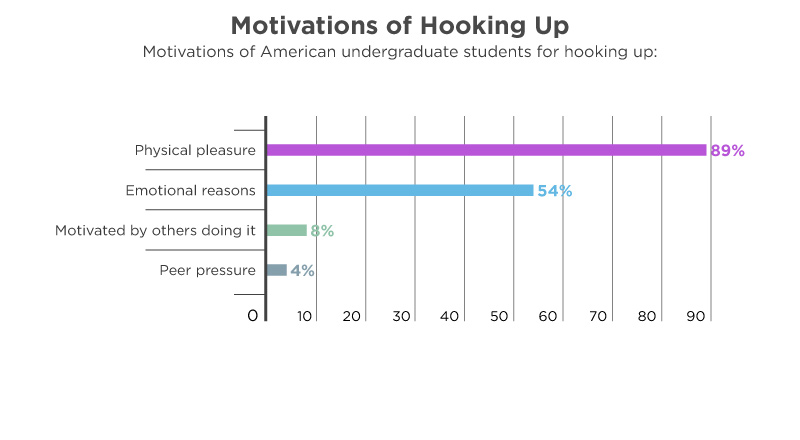
- Motivations of American undergraduate students for hooking up:
- Physical pleasure — 89%
- Emotional reasons — 54%
- Motivated by others doing it — 8%
- Peer pressure — 4%
(Journal of Social, Evolutionary, and Cultural Psychology, 2008)12
Drugs and Alcohol’s Role in Hookups
Perhaps not so shockingly, alcohol and other intoxicants are important factors in hooking up, having a major effect on what people do, how often they do it, and what kind of behavior actually takes place.
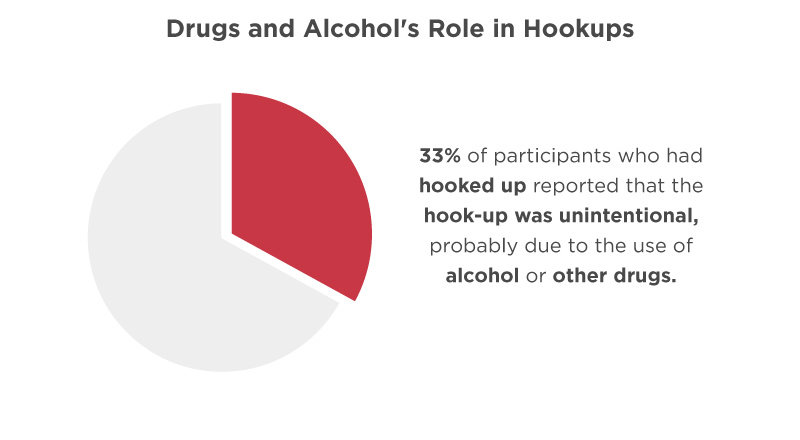
- Alcohol intoxication plays a powerful predictive role in coital hookups. Actual or perceived symptoms of intoxication also play a large role in engagement with risky sexual activities. (Journal of Sex Research, 2010)13
- In one study, 33% of participants who had hooked up reported that the hook-up was unintentional, probably due to the use of alcohol or other drugs. (Journal of Social, Evolutionary, and Cultural Psychology, 2008)12
- In another study, first-semester female college students reported that 64% of their hookups happened after alcohol use, with a median of 3 drinks. (Journal of Sex and Marital Therapy, 2010)14
- 67.5% of males who drank before hooking up drank an average of 6.67 drinks, and among the 64.9% of females who drank before hooking up, they averaged 4.82 drinks. (The Journal of Sex Research, 2014)15
- Among college students who consumed alcohol prior to their last hookup, 30.7% of females and 27.9% of males indicated that they would most likely not have hooked up with their partners had alcohol not been involved. Further, 34.4% of females and 27.9% of males indicated that they would not have gone as far physically if they had not been drinking. (The Journal of Sex Research, 2014)15
The Different Responses After Hooking Up
How do different people react to hookups?
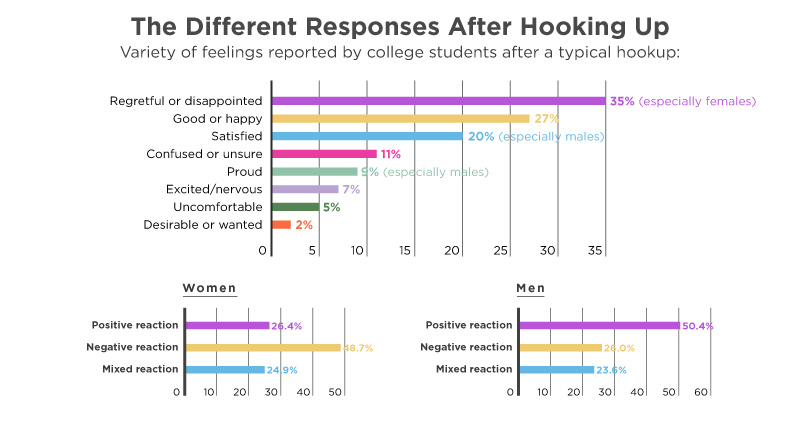
- 86.3% of undergraduate students described their most recent hookup experience as an experience they wanted to have. A smaller proportion (7.6%) of students indicated that their most recent hookup experience was an experience they did not want to have or were unable to give consent to. (Archives of Sexual Behavior, 2011)6
- Variety of feelings reported by college students after a typical hookup:
- Regretful or disappointed — 35% of college students (especially females)
- Good or happy — 27% of college students
- Satisfied — 20% of college students (especially males)
- Confused or unsure — 11%
- Proud — 9% (especially for males)
- Excited/nervous — 7%
- Uncomfortable — 5%
- Desirable or wanted — 2%
(American Psychological Association, 2013; Journal of Social and Personal Relationships, 2002)8,16
- Reaction type of men and women after a typical hookup:
- Women
- Positive reaction — 26.4%
- Negative reaction —- 48.7%
- Mixed reaction — 24.9%
- Men
- Positive reaction — 50.4%
- Negative reaction —- 26.0%
- Mixed reaction — 23.6%
- Women
(Archives of Sexual Behavior, 2008)17
Reasons Why People Sometimes Regret Hooking Up
As we’ve just seen, not every reaction to hooking up is positive. On the contrary, mixed and even negative feelings about it happen quite frequently. Why is this?
- Of those who had uncommitted sexual encounters or ‘casual sex,’ 72% of men and 78% of women reported an experience of regret after. (Culture, Health & Sexuality, 2011)18
- 56% of men and 55% of women agreed that intoxication by alcohol and/or drugs caused them to feel regret following a hookup. (Culture, Health & Sexuality, 2011)18
- In one study, the quality of the sex itself influenced feelings of regret experienced by nearly one-third of the women (32.2%) and 41.8% of the men. (Culture, Health & Sexuality, 2011)18
- Men (30%) were more likely than women (12%) to regret a hookup because of a lack of physical attraction. (Culture, Health & Sexuality, 2011)18
- Percentage of participants reporting physical versus emotional reasons for regret by gender:
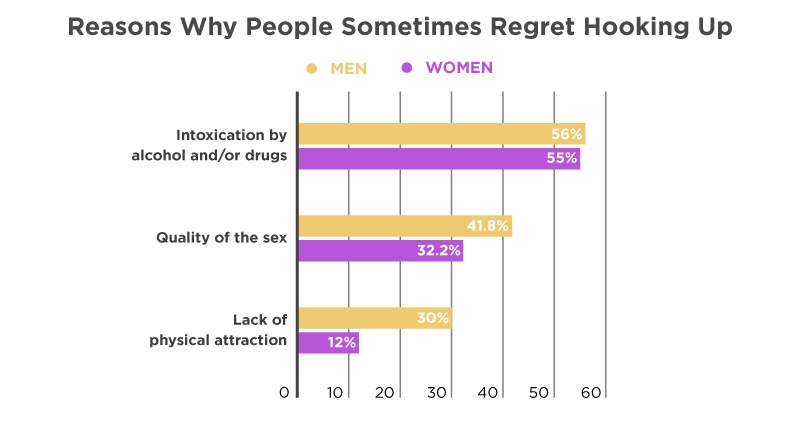
- Physical reasons
- “Not gratifying”
- Women — 23%
- Men — 28%
- “Not physically attracted”
- Women — 11%
- Men — 30%
- “Unprotected sex”
- Women — 25%
- Men — 35%
- “Not gratifying”
- Emotional reasons
- “First time should be special”
- Women — 20%
- Men — 35%
- “Cheating on partner”
- Women — 30%
- Men — 23%
- “Ruined friendship”
- Women — 21%
- Men — 23%
- “Hardly knew other person”
- Women — 44%
- Men — 34%
- “Guilty, but not sure why”
- Women — 26%
- Men — 23%
- “Wanted future relationship”
- Women — 12%
- Men — 23%
- “First time should be special”
- Physical reasons
(Culture, Health & Sexuality, 2011)18
Benefits and Risks of Hookups
What’s the good, the bad, and the ugly when it comes to casual sex encounters?
- Benefits
- 71% of undergraduate women report at least one benefit from their most recent hookup. Among those reporting benefits, 65% listed one benefit, 30% listed two, 5% listed three, and 1% listed four benefits, for an average of 1.4 benefits per woman. (International Journal of Sexual Health, 2016)19
- The most frequent benefits were sexual pleasure (23%) and general positive emotions (21%). 29% noted there was no benefit to their most recent hookup. (International Journal of Sexual Health, 2016)19
- Hookup Benefits by percentage of women endorsing:
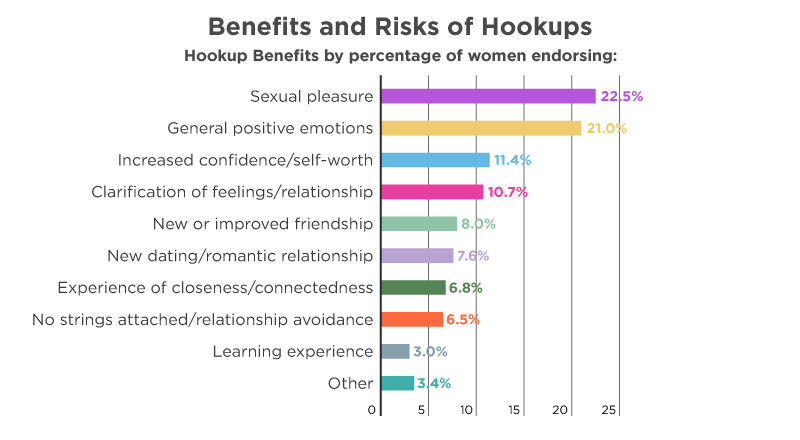
- Sexual pleasure — 22.5% (59 women)
- General positive emotions — 21.0% (55 women)
- Increased confidence/self-worth — 11.4% (30 women)
- Clarification of feelings/relationship — 10.7% (28 women)
- New or improved friendship — 8.0% (21 women)
- New dating/romantic relationship — 7.6% (20 women)
- Experience of closeness/connectedness — 6.8% (18 women)
- No strings attached/relationship avoidance — 6.5% (17 women)
- Learning experience — 3.0% (8 women)
- Other (e.g., Memories, it was funny, good story, etc.) — 3.4 (9 women)
(International Journal of Sexual Health, 2016)19
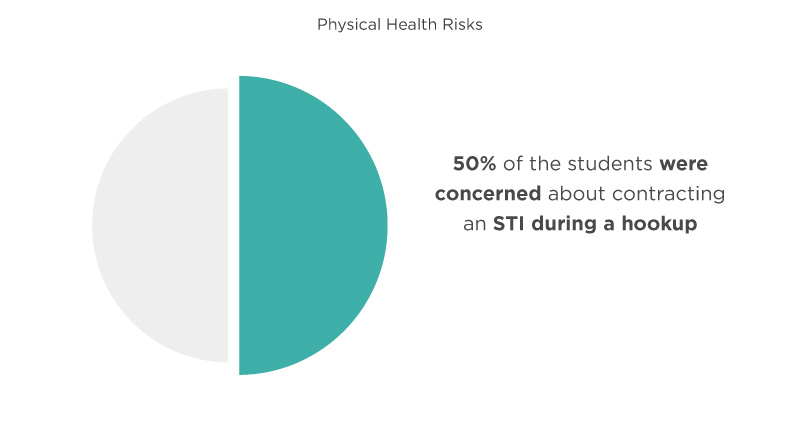
- Physical Health Risks
- In one study, only about 50% of the students were concerned about contracting an STI during a hookup that involved sexual intercourse, and the majority of students were not concerned about contracting an STI during a hookup that went only as far as fellatio or cunnilingus. (Qualitative Health Research, 2009)20
- Reasons by students why they are not concerned about contracting STIs:
- They trust their partners too much, i.e., more than their partner’s behavior should merit.
- They trust their community too much; they believe they have a low prevalence of HIV/AIDS in their state.
- They were inadequately informed of the risk of STIs, especially with respect to oral sex.
(Qualitative Health Research, 2009)20
- About 74% of the students have some level of acquaintance with their partners before hooking up with them, influencing the degree to which they believed they are at risk of STIs. (Qualitative Health Research, 2009)20
- Students acquainted with their partners often indicated that they felt safe around them because of their characteristics. (Qualitative Health Research, 2009)20
- Only about 25% of the students in the same study indicated that HIV was of concern to them regardless of the prevalence of HIV in their community/state. (Qualitative Health Research, 2009)20
- Less than 5% of students stated that they had been concerned about STIs following oral sex. (Qualitative Health Research, 2009)20
- A different study found that condom use among students having oral, vaginal, or anal sex during hookups was 46.6% (Archives of Sexual Behavior, 2011)6
- Mental Health Risks
- In a 2013 study, researchers found that a significant level of negative physical and mental health issues is experienced in conjunction with hookups.
(Journal of Midwifery and Women’s Health, 2013)21
- In a 2013 study, researchers found that a significant level of negative physical and mental health issues is experienced in conjunction with hookups.
- Percentage of negative mental and physical health issues experienced by students due to hookups:
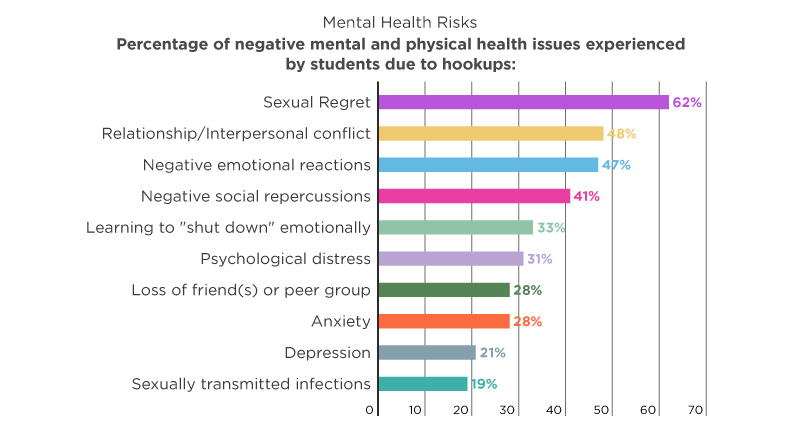
- Sexual Regret — 62%
- Relationship/Interpersonal conflict — 48%
- Negative emotional reactions — 47%
- Negative social repercussions — 41%
- Learning to “shut down” emotionally — 33%
- Psychological distress — 31%
- Loss of friend(s) or peer group — 28%
- Anxiety — 28%
- Depression — 21%
- Sexually transmitted infections — 19%
(Journal of Midwifery and Women’s Health, 2013)21
- As a result of the hookup, students indicated having experienced the following negative effects:
- “a loss of respect” — 20.8% of students
- “feeling embarrassed” — 27.1% of students
- “emotional difficulties” — 24.7% of students
- “difficulties in a relationship with a steady partner” — 10.0% of students
- “breaking up with a steady partner” — 2.5% of students
- “unwanted pregnancy” — 2% of students
- “sexually transmitted infection” — 0.9% of students
(Archives of Sexual Behavior, 2011)6
American’s Hookup Preferences
Everyone has their preferences for what they’re looking for in any kind of relationship, even casual ones and hookups.
What do Americans who engage in hookups actually want? What are they looking for?
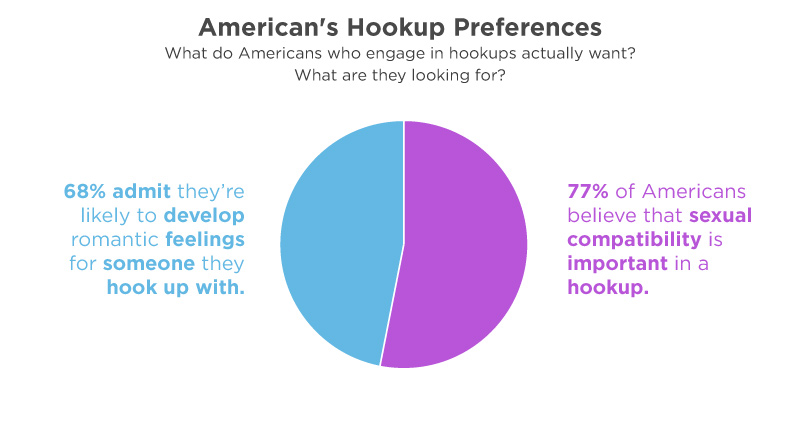
- 69% of Americans would only start a “no strings attached” relationship with someone they had chemistry with. (Study Finds, 2021)3
- 77% of Americans believe that sexual compatibility is important in a hookup. (Study Finds, 2021)3
- 64% of Americans are interested in relationships that have “no strings attached.” (Study Finds, 2021)3
- 55% of Americans would hook up with someone who looks similar to their favorite celebrity. (Study Finds, 2021)3
- 22% of Americans attempt to get to know the people they hook up with properly, and 52% of them want to get to know their partner before having sex. (Study Finds, 2021)3
- Three in four Americans think it’s important that their hookup is polite and has good communication skills. (Study Finds, 2021)3
- 21% of Americans also value others who have similar moral views. (Study Finds, 2021)3
- Half of Americans (49%) claim to value looks and personality equally when choosing a hookup. (Study Finds, 2021)3
- Two-thirds of Americans size up their potential mate’s style, and nearly half are more likely to hook up with someone who posts “racy” photos online. (Study Finds, 2021)3
- Two in three Americans thought they were so compatible with a previous hookup that they wished they could have started a serious relationship with them afterward. (Study Finds, 2021)3
- Another 68% admit they’re likely to develop romantic feelings for someone they hook up with. (Study Finds, 2021)3
- 18% of respondents rarely or never hook up with the same person more than once — citing that they “don’t want unnecessary attachment,” “it may lead to uncomfortable scenarios, or “because it’s no longer hooking up.” (Study Finds, 2021)3
- Half of Americans would be willing to hook up with a friend, and 46% would do so with an ex. However, a third of respondents would rather have a casual encounter with someone from a website or app match (32%). (Study Finds, 2021)3
Friends With Benefits: A Unique Variation of Hookup
More than a hookup but not a relationship, friends with benefits treads the middle ground between keeping things light and enjoying spending time with someone outside of sleeping together.
Proponents might say that friends with benefits (FWB) is a better alternative because you get to enjoy someone’s company, and friends are a good thing to have.
So what’s the deal with FWB?
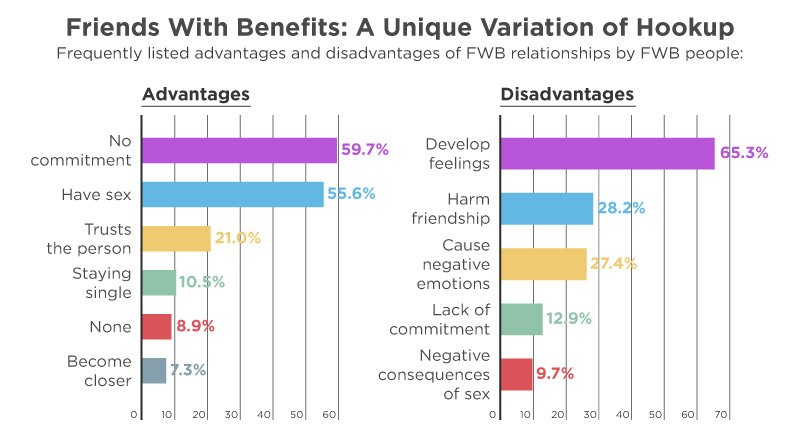
- One study found that 60% of 125 undergraduates (40 men and 35 women) reported having had an FWB relationship at some point in their life, and over one-third (36%) were currently engaging in sex with “just a friend” (17 men and 10 women). (Archives of Sexual Behavior, 2007)22
- Of people who engaged in FWB relationships, 98.7% were with an opposite-sex partner, and 1.3% were with a same-sex partner. (Archives of Sexual Behavior, 2007)22
- The majority (52.1%) of people in FWB relationships had an “occasional” frequency, 29.3% had “ongoing/frequent” hookups, and the remaining 18.7% had sex “only once” in their FWB relationship. (Archives of Sexual Behavior, 2007)22
- People with experience in FWB relationships had different types of sex throughout their FWB relationships. 22.7% of them had “intercourse only,” 2.7% had “oral sex only,” 1.3% claimed to have “genital touching only,” 8.0% had “both oral sex and genital touching,” and 56% of FWB people experienced them all. (Archives of Sexual Behavior, 2007)22
- In the end, 25.9% of respondents in the same study had their FWB relationship ended, 35.8% stayed friends but stopped having sex, 28.3% stayed in an FWB relationship, and 9.8% turned their FWB relationship into a romantic relationship. (Archives of Sexual Behavior, 2007)22
- Frequently listed advantages and disadvantages of FWB relationships by FWB people:
- Advantages
- No commitment — 59.7% of FWB people listed this as an advantage
- Have sex — 55.6%
- Trusts the person — 21.0%
- Staying single — 10.5%
- None — 8.9%
- Become closer — 7.3%
- Disadvantages
- Develop feelings — 65.3% of FWB people listed this as a disadvantage
- Harm friendship — 28.2%
- Cause negative emotions — 27.4%
- Lack of commitment — 12.9%
- Negative consequences of sex — 9.7%
- Advantages
(Archives of Sexual Behavior, 2007)22
Best Hookup State and City in The United States
Maybe you’ve read enough about hookups by now and are convinced to pursue them yourself.
Or maybe you’d like to know which areas to avoid if you want a serious relationship.
Heck, maybe you’re just curious.
So which cities and states have the highest proportion of people after a hookup?
- Rhode Island is considered the “thirstiest” state, based on google search data for hookup-related terms. (Four Loko, 2018)23
- Based on Google search volume per capita, Denver was the hottest hookup city in the United States. (Four Loko, 2018)23
Dating vs. Hookups: Which Are More Common These Days?
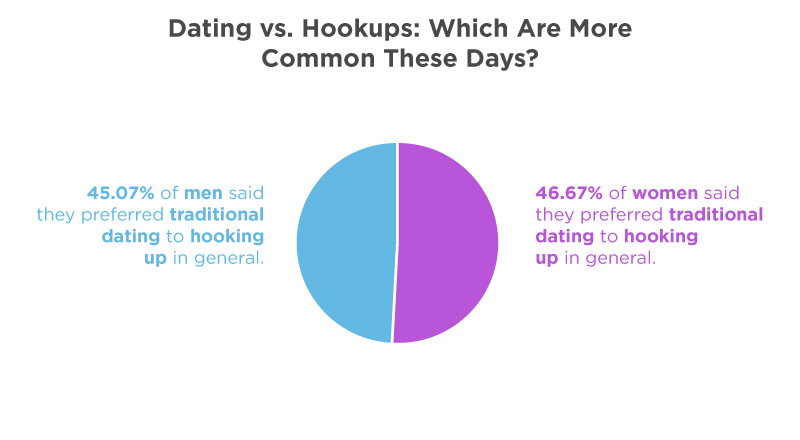
- The prevalence of hookups involving oral or vaginal sex was 34% before college and 40% during the first year, compared to 58% and 56%, respectively, with romantic partners. (Journal of Adolescent Health, 2012)24
- Fewer than 1 in 5 participants (7–18%) had a sexual hookup each month, whereas 25–38% had sex in the context of relationships each month. (Journal of Adolescent Health, 2012)24
- Of those students who strongly preferred traditional dating, there were significantly more women than men. (41% for women versus 20% for men). (Sex Roles, 2010)25
- Significantly more men (17%) showed a strong preference for hooking up over dating than women (2%). (Sex Roles, 2010)25
- 46.67% of women and 45.07% of men said they preferred traditional dating to hooking up in general. (Big Think, 2010; Sex Roles, 2010)26,25
- 95.3% of women and 77.47% of men have some degree of preference for traditional dating over hookups. (Big Think, 2010; Sex Roles, 2010)26,25
Conclusion
So, is hooking up taking over from dating any time soon?
Based on the numbers, it doesn’t seem likely. Of course, there will always be people who prefer to keep things casual for a variety of reasons, but dating and relationships aren’t going anywhere.
Footnotes
- Journal of American College Health, 2018. A study of 396 heavy drinking American college students.
- Archives of Sexual Behavior, 2013. A study of 163 American undergraduates in their first year in college.
- Study Finds, 2021. An article about a survey of 2,000 Americans about their preferences when it comes to hookups or casual relationships.
- Review of General Psychology, 2012. A study of the sexual hookup culture.
- University of California Merced, 2010. A study of more than 14,000 American students from 19 universities and colleges.
- Archives of Sexual Behavior, 2011. A study of 824 American undergraduates who have hooked up.
- Adolescent & Family Health, 2003. A study of a nationally representative sample of 2,344 American adolescent virgins who had never dated.
- American Psychological Association, 2013. An article about the studies of sexual hook-up culture.
- Social Science Research, 2005. A study of 18,924 American adolescent students in grades 7 through 12.
- Evolutionary Psychology, 2010. A study of 507 American college students.
- Psychology Today, 2020. An article about a survey of 1,121 respondents about casual sex.
- Journal of Social, Evolutionary, and Cultural Psychology, 2008. A study of 507 American undergraduate students.
- Journal of Sex Research, 2010. A study of 555 American undergraduate students.
- Journal of Sex and Marital Therapy, 2010. A study of 118 American first-semester female college students.
- The Journal of Sex Research, 2014. A study of 828 American college students.
- Journal of Social and Personal Relationships, 2002. A study of 187 American college students.
- Archives of Sexual Behavior, 2008. A study of 832 American college students.
- Culture, Health & Sexuality, 2011. A study of 200 Canadian university students.
- International Journal of Sexual Health, 2016. A study of 262 responses from female American undergraduates.
- Qualitative Health Research, 2009. A study of 71 college students.
- Journal of Midwifery and Women’s Health, 2013. A study of 210 American liberal arts students.
- Archives of Sexual Behavior, 2007. A study of 125 American undergraduates.
- Four Loko, 2018. An article about the best hookup hotspots in the United States.
- Journal of Adolescent Health, 2012. A study of 483 first-year American female college students.
- Sex Roles, 2010. A study of 221 American university students.
- Big Think, 2010. An article about dating vs. hooking up preference by men and women.